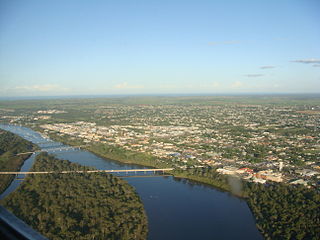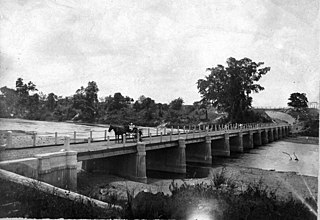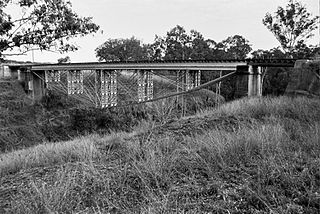
Bundaberg is a city in the Bundaberg Region, Wide Bay, Queensland, Australia, and is the tenth largest city in the state. Bundaberg's urban area has a population of 73,747, and is a major centre of the Wide Bay–Burnett geographical region. The Bundaberg central business district is situated along the southern bank of the Burnett River, about 20 km (12 mi) from its mouth at Burnett Heads, and flows into the Coral Sea. The city is sited on a rich coastal plain, supporting one of the nation's most productive agricultural regions. The area of Bundaberg is the home of the Taribelang-Bunda, Goreng Goreng, Gurang, and Bailai peoples. Popular nicknames for Bundaberg include "Bundy", "Rum City", and "The 'Berg". The demonym of Bundaberg is Bundabergian.

Lamington Bridge is a heritage-listed road bridge over the Mary River from Gympie Road, Tinana to Ferry Street, Maryborough, both in the Fraser Coast Region, Queensland, Australia. It was designed by Alfred Barton Brady and built from c. 1896 to 1970 by McArdle & Thompson. It was added to the Queensland Heritage Register on 21 October 1992.

Bundaberg Central is the central suburb and central business district of Bundaberg in the Bundaberg Region, Queensland, Australia. In the 2021 census, Bundaberg Central had a population of 162 people.

Imbil Railway Bridge is a heritage-listed railway bridge over Yabba Creek, Imbil, Gympie Region, Queensland, Australia. It was built circa 1915 by Queensland Railways to facilitate settlement in the Mary River Valley. It was added to the Queensland Heritage Register on 14 October 2011.

The Maryborough Customs House is a heritage-listed former customs house at Richmond Street, Maryborough, Fraser Coast Region, Queensland, Australia. It was designed by John Smith Murdoch and built in 1899. It was added to the Queensland Heritage Register on 7 February 2005.

South Sea Islander Wall is a heritage-listed plantation at Grange Road, Mon Repos, Bundaberg Region, Queensland, Australia. It was built circa 1884 by South Sea Islander labour. It was added to the Queensland Heritage Register on 1 October 2001.

Bundaberg Police Station is a heritage-listed former court house (1882–1958) and former police station (1958–1997) at Quay Street, Bundaberg Central, Bundaberg, Bundaberg Region, Queensland, Australia. It was built from 1882 to 1958. It is also known as Bundaberg Court House. It was added to the Queensland Heritage Register on 1 December 1998.

Burnett Bridge is a heritage-listed road bridge crossing the Burnett River from Quay Street, Bundaberg Central to Perry Street, Bundaberg North in Bundaberg, Bundaberg Region, Queensland, Australia. It was designed by Alfred Barton Brady and built in 1900. It is also known as Burnett River Traffic Bridge. It was added to the Queensland Heritage Register on 21 October 1992.

Commercial Bank of Sydney is a heritage-listed former bank building at 191–193 Bourbong Street, Bundaberg Central, Bundaberg, Bundaberg Region, Queensland, Australia. It was designed by George Allen Mansfield and built in 1891. It is also known as the National Australia Bank. It was added to the Queensland Heritage Register on 21 October 1992.

East Bundaberg Water Tower is a heritage-listed water tower at 17 Sussex Street, Bundaberg East, Bundaberg Region, Queensland, Australia. The tower is the only circular brick water-tower in Queensland and was designed by James Baillie Henderson and built from 1901 to 1902. It was added to the Queensland Heritage Register on 21 October 1992.

Bundaberg East is a suburb of Bundaberg in the Bundaberg Region, Queensland, Australia. In the 2016 census Bundaberg East had a population of 2,784 people.

Alfred Barton Brady (1856-1932)was an engineer and architect in Queensland, Australia. He was one of Queensland's most important early engineers and was particularly known for his bridge design. He was the Queensland Colonial Architect and many of his buildings and structures are now heritage-listed.

Saltwater Creek Railway Bridge is a heritage-listed railway bridge over Bundaberg Creek on Quay Street from Bundaberg Central to Bundaberg East in Bundaberg, Bundaberg Region, Queensland, Australia. It was built in 1894 by James Overend. It is also known as Millaquin Bridge. It was added to the Queensland Heritage Register on 21 October 1992.

Sir Anthony's Rest is a heritage-listed dry-stone lookout at Sir Anthony's Rest Street, Qunaba, Bundaberg Region, Queensland, Australia. It was built for the official visit of the Governor of Queensland, Sir Anthony Musgrave, to Bundaberg in his 1888 tour of the area. It is located on the summit of the Bundaberg Hummock hill and provides a commanding view of the surrounding Bargara canefields.

Gairloch Bridge is a heritage-listed road bridge over the Herbert River at Old Bruce Highway, Ingham, Shire of Hinchinbrook, Queensland, Australia. It was designed by Alfred Barton Brady and built from 1890 to 1891 by James Graham. It was added to the Queensland Heritage Register on 17 July 2008.

Ideraway Creek Railway Bridge is a heritage-listed railway bridge at Mungar - Monto Line, Ideraway, North Burnett Region, Queensland, Australia. It was designed by William Pagan and built from 1906 to 1907 using day labour. It was added to the Queensland Heritage Register on 21 October 1992.

Humphery Railway Bridge is a heritage-listed railway bridge on the Mungar to Monto railway line at Humphery, North Burnett Region, Queensland, Australia. It was designed by William Pagan and built in 1913. It was added to the Queensland Heritage Register on 21 October 1992.

Bundaberg Central State School is a heritage-listed state school at 13 Crofton Street, Bundaberg Central, Bundaberg, Bundaberg Region, Queensland, Australia. It was designed by Robert and John Ferguson and the Queensland Department of Public Works and built in 1890 by William Calvert. It is also known as Bundaberg South State School. It was added to the Queensland Heritage Register on 28 November 2014.

Branyan Road State School is a heritage-listed state school at Branyan Drive, Branyan, Bundaberg, Bundaberg Region, Queensland, Australia. It was designed by Queensland Department of Public Works and built in 1905. It was added to the Queensland Heritage Register on 1 May 2015.
Bundaberg–Bargara Road is a state-controlled district road in the Bundaberg region of Queensland, Australia. It is rated as a local road of regional significance (LRRS). It runs from the Isis Highway in Bundaberg West to Holland Street in Bargara, a distance of 14.4 kilometres (8.9 mi).























